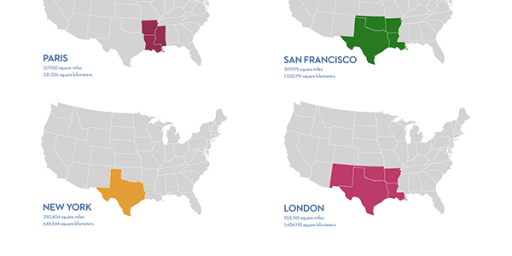Africa’s Size
This map and comparison (via io9) is pretty awesome, because it really provides a better view of the size of the African continent than go most maps, which due to the nature of standard projections makes the northern hemisphere look larger than it is (and conversely makes the southern hemisphere look too small). I seen maps (some below) that seek to correct this distortion, but I have never seen one that puts it this clearly:

Maps are tricky, because they are flat, but the Earth is a sphere, this leads to distortions when maps are drawn.
We typically think the world looks like the (Mercator projection):

However, a more accurate view is the Peters Projection:

One can see why the Mercator projection would be more popular with the denizens of the Northern hemisphere than would be the Peters projection.
Here’ a cool one that superimposes one over the other:

There are other attempts to project the spherical world onto a flat surface, but the contrast between these two demonstrate the basic debate. Apart from the technical aspects, this is all pretty important from a political point of view. The Mercator projection for example, makes Europe a lot more focus than the Peters does. Size affects perception, as does position.
After all, politics is at the hear of why the map doesn’t look like this:
And why a post about maps? Because maps are cool, that’s why.






So are bow ties, fez’s and cowboy hats.
The Mercator Project was primarily intended for ocean navigation and has the useful property that if you plot straight line from your current location, it incdicates the path you will travel if you travel in that particular heading (e.g. a line at 45 degrees depicts the course you would follow if you went steadily NE).
One of my all time favorite episodes of The West Wing dealt with this. I think it is one of my favorites because I never realized how cool maps could be.
http://www.youtube.com/watch?v=n8zBC2dvERM
@Doug Mataconis: Exactly.
@Stormy Dragon: Fair enough–but it has become “the” map we are taught from and it shapes (no pun intended) our view of the world.
@Neil Hudelson:
That was part of Big Block Of Cheese Day!
@Neil Hudelson: That was a great episode.
Maps=cool. Great map to lead this post.
Ob XKCD:
http://xkcd.com/977/
Although I actually like the Gall-Peters projection myself.
@Steven L. Taylor:
My point was that people unfairly dump on Mercator. It was created for a particular purpose and it remains the best projection for that particular purpose. You can’t really blame the projection when publishers misuse it in situations where an equal-area projection would be more appropriate.
@Stormy Dragon:
Although I think the Gall-Peters projection could be improved by moving the standard lattitude to 37.688 N (the geographic midpoint of earth’s landmasses) rather than 45 N, where Gall-Peters puts it.
This would result in something similar to the Hobo-Dyer projection that maintains the equal area property present in all Lambert Cylindrical projections while minimizing the average distortion for the land area of the planet.
Years ago someone left an inflatable globe at my house. It’s still rolling around, after all these years. At seven bucks, a winner.
As soon as I saw what the post was about I immediately thought of “The West Wing”.
I like the upside down map because it also puts the Pacific in the middle rather than the Atlantic.
“Hey, I’m going up to Florida”
“Don’t you mean you are going down to Florida?”
“… Seriously?”
There’s a logical reason for north to be the top: compasses point at the north pole, not the south. But the rest is pretty arbitrary. And yeah, I can see the psychological implications of using the Mercator — subtle, but logical.
Ken Jennings’ book Maphead is a fun read if you are into maps.
Dammit, now I want a fez.
@Jenos Idanian #13: You’re joking, right? The first magnets didn’t have one end painted red. It’s more likely due to most of the land mass being in the northern hemisphere.
Peters is NOT more accurate. It simply distorts in a different fashion. And is a despised horror among those who know. Good lord. At least use some modern and appropriate projection, not one universally despised by map makers and aficionados.
I have an upside down world map hanging in my bedroom at home. It is really cool and helps to give you a new perspective. But people really unfairly dump on the Mercator projection, coming up with dumb conspiracy theories, saying these eurocentric maps are a way for white people to be special. In reality, the eurocentric Mercator maps are the product of a very logical process.
First, one has to understand why north is on top. During the middle ages, European maps were with east up. Why? Because maps were oriented to the Orient. These words are not similar by accident, It was probably related to the sun rising in the east. Later, after the compass became widespread in use, the orientation of the map changed to reflect the newer, more reliable method of orientation. So it was an organical process.
Even in the modern age, putting north at the top makes sense, since it contains most of the Earth’s landmass and about 90% of human population. Additionally, land in the northern hemisphere goes north much farther than land on the southern hemisphere goes south. South of 40° southern latitude is only Tasmania, the South Island of New Zealand, and the lesser populated halfs of Argentina and Chile, while north of 40° northern latitude is half of the contiguous USA, the whole of Kanada, Russia, Mongolia, Kazakhstan, one third of China and nearly all of Europe, save parts of Greece, Italy, Spain and Portugal. There are big landmasses north of 60°, while there is no land, save the uninhabited Antarctic, south of about 56° Now imagine a globe with south on top. You would be permanently craning your neck to look at the underside to see big parts of the world, while the same problem is not present with north on top.
Regarding the position of Europe in the middle, it is an outgrowth of European explorers being the first to map the whole world. It is one of only two methods to place the center, since the cut on 180° longitude is in the Pacific Ocean, so it does not cut through any big landmasses, save the extreme end of Siberia. The other place is at about 150° eastern longitude (Sydney in the center of the map), since that cuts through the Atlantic Ocean (and Greenland).
But of course politics is NOT the reason why Europe is at the center. Take a vacation in a forest, make a base camp and begin exploring the forest, making a map of it. How will it go? You will likely mark down your base at the center of the map, and add the charted territory as you explore the forest. Is it a politcal reason why you put your base camp at the center of the map, or a logical outcome of the exploration and map making process? Of course the latter, the same reason is why maps of European had Europe at the center. There is nothing political about that.
And using the Mercator projection is because you needed the preserved angles to navigate the sea, and the first who made world maps were the seafaring nations. This is simply an artifact of that time, and there is nothing wrong with still using them. There is also nothing wrong with switching to a less distorting system, but the inertia is probably on the side of the Mercator projection.
The overlay is pretty good for size comparison.
For less distortion I like the Winkel Tripel or the Goode homolosine maps.
@Lounsbury: I fully understand that the Peters projection has its own issues. It is, however, rather eye-opening if all one has ever paid attention to is the Mercator projection.
Mercator makes Greenland and Africa look roughly the same size, for example.
@Steven L. Taylor: When I’ve heard discussion of the problems of Mercator projection (years ago) it was usually by comparison of Greenland and Australia, not Africa.
I work in GIS systems pretty heavily in my day job, and there’s another reason that Mercator remains one of the most popular map projections: the math is butt simple. Map projections require a lot of computation. Depending on the projection, some of them really a *LOT* of computation. Mercator is simple: you take -180 to positive 180 and map it to the X axis, -90 to positive 90 and map it to the y axis and you’re done. That’s it. That’s just about as simple as it can possibly get when you’re mapping a sphere to a plane.
We don’t continue to use Mercator because we’re biased. We continue to use it because it takes a freakin’ lot of work (if you’re doing it by hand) or computer power (if you’re doing it in real-time) to do anything else.
Now, I’ve actually implemented other map projections in real-time, so I’m not saying it can’t be done. But it’s a ton of effort to do, and at the end of the day it’s not even worth it because nobody cares. Mercator is loaded with problems, yes. And the end users just don’t care.
You can’t win anyway because every map projection has problems. It’s inherent in the problem of trying to map a sphere to a plane. It can’t be done in any way that preserves all of the properties of the spherical layout. You have to choose which ones to preserve. As Stormy Dragon pointed out, Mercator was intended to preserve navigational headings – but you end up with landmass size distortion. I’ve used other projections intended to preserve distance, radials, shapes and more. But in each case you lose something. And again, most of the time the end users just don’t care – if they even know about it. So most of the time you just give up and go with Mercator because it’s easy and it’s fast.
Trying to make accurate flat maps of a globe is really hard. We have a joke around the office: thank God that the Earth is round, because if it were flat we’d be out of work. And we have ridiculously powerful computers available to help us out. Remember that many of the most common map projections we use today were created by men who didn’t even have sliderules to help them out. Try to cut them a bit of slack and not just assume that they were biased in their creations.
@Lounsbury:
Except as your own link points out: 1) it’s not universally despised, and has both supporters and detractors among the cartography community, 2) to the extent it is despised, it’s largely for reasons related to their opinion of Arno Peters rather than issues with the projection itself.
One could argue that a significant portion of the profession apparently makes their decisions based on political affiliation of the person making an argument rather than the scientific content of the argument itself only serves to reinforce Peters argument.
@Console:
You joke, but I’ve notice my parents always refer to travelling someplace else as “going down to X” regardless of what direction X is relative to their home.
@Russell Newquist:
Of course, that applies to ANY cylindrical projection. You also have to look at the transform being applied to the y axis. Mercator, which requires the calculation of a division and two transcendental functions is far more computationally intensive than one of the Lambert equal area cylindrical projections which only requires calculating a single transcendental function.
@Stormy Dragon:
It’s the bloody wikipedia, you dim git, the very source of brain dead presentation. The Peters projection is sub-optimal shite whose only reason to be in prominence is in fact politics. In fact it is universally despised among those not with some absurd politics.
@Stormy Dragon: …better yet, my wife’s relatives (east coast) seem to always say “shoot on over to this place or on this hwy” regardless of direction.
This is a fascinating topic!
@Russell Newquist:
Do you mind sharing the purposes of your other map projections?
@Tran:
I understand the basic point about the map starting where one is. But what you have defined here is actually pure politics. The map being draw from the perspective of Europe is because of Europe’s political, military, and economic power. The Prime Meridian is where the Prime Meridian is because of politics.
It is most certainly not because of a conspiracy, but the map being Eurocentric is because it was drawn and distributed by Europeans. And putting Europe in the center of the world is a political statement, whether intended as such or not.
Understand: I am not saying burn the Mercator maps, or that we should stop using them, but from the point of view of political understanding that map has certain implications that many take as natural or just simply normal without recognizing the unconscious biases behind our assumptions.
@Lounsbury: The point of showing a Peters projection is not, at least to me, to argue for its as the best map. The point is that it does underscore the way the map we tend to be used to (i.e., Mercator) does distort the relative sizes of the continents fairly significantly. That distortion affects perception of the world, which does have political (and pedagogical) implications.